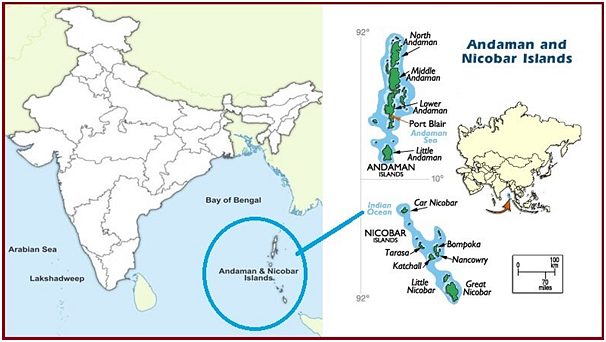Description

Copyright infringement not intended
Picture Courtesy: https://swarajyamag.com/infrastructure/explained-development-plan-of-great-nicobar-islands
Context: A group of experts have written to the National Commission of Scheduled Tribes (NCST) expressing concerns about the Great Nicobar Project in India.
Details
- The letter to the National Commission of Scheduled Tribes is signed by a group of anthropologists, social scientists, environmentalists, and tribal studies scholars with extensive experience working with indigenous communities in the Andaman and Nicobar Islands and across India.
- The signatories highlight the urgent need to safeguard tribal rights, protect biodiversity, and uphold constitutional mandates in the face of large-scale development projects that threaten indigenous territories and ecosystems.
About the Great Nicobar Project
- The Great Nicobar Project, a massive infrastructure development initiative, has raised significant concerns among experts regarding its potential adverse impacts on the indigenous population, particularly the Shompen and Nicobarese tribes, inhabiting the Great Nicobar Island.
Violation of Constitutional Mandate
- More than half of the planned project area, amounting to 84.10 sq km, lies within the Tribal Reserve Area, which is currently used by the Shompen tribe for their livelihood and cultural practices.
- The diversion of this tribal reserve area for the infrastructure project violates constitutional provisions aimed at protecting the rights and interests of scheduled tribes.
Environmental and Cultural Concerns
- Destruction of Primary Forests: The project entails the destruction of primary forests and rich biodiversity, which are crucial habitats for the indigenous communities and support unique flora and fauna, including nesting sites of endangered species like the giant leatherback turtle.
- Impact on Tribal Livelihood: The project's development threatens the traditional livelihoods of the Shompen and Nicobarese tribes, who rely on forest resources and coastal ecosystems for sustenance and cultural practices.
Legal Lacunae in Project Clearances
- Denotification of Tribal Reserve: The denotification of tribal reserve areas for the project lacks proper justification and consultation with affected tribal groups, contravening legal safeguards under the Scheduled Tribes and Other Traditional Forest Dwellers (Recognition of Forest Rights) Act, 2006.
- Flawed Compensation Measures: The proposal to compensate for denotified tribal reserve areas by re-notifying other land parcels fails to consider the unique needs and cultural significance of the affected indigenous communities.
Lack of Consultation and Inclusion
- Disregard for Indigenous Views: The decision-making process disregarded the views and concerns expressed by the indigenous communities, as evidenced by the exclusion of critical input provided by community members in official reports and committee deliberations.
- Violation of Regulatory Provisions: The project approval process overlooks regulatory provisions, such as those outlined in the Andaman and Nicobar Islands (Protection of Aboriginal Tribes) Regulation, 1956, which prioritise the protection of tribal interests and cultural heritage
Advocacy for Tribal Rights and Environmental Conservation
- Demand for Transparency: The experts advocate for greater transparency in the decision-making process, urging public disclosure of meeting minutes and circulars related to tribal reserve de-notification.
- Inclusive Consultation: They emphasise the importance of inclusive consultations with affected tribal groups to ensure that any decisions regarding tribal reserve areas align with constitutional directives and the welfare of indigenous communities.
|
Great Nicobar Island
●The Great Nicobar Island, part of India's Andaman and Nicobar Islands, is a region of ecological and cultural significance, hosting unique biodiversity and indigenous communities.
●The island has been recognized by Indian mariners since the era of the seafaring Chola dynasty.
●Recorded as "Cui Lan Island" during the voyages of Zheng He in the 15th century.
●Features rivers flowing southward, and a main north-south range with Mount Thullier as its highest point.
●Home to unique and endemic species like the Nicobar scrubfowl, edible-nest swiftlet, Nicobar long-tailed macaque, saltwater crocodile, giant leatherback sea turtle, and others.
●Inhabited by the Shompen people, reflecting a rich cultural heritage tied to the island's ecology and resources.
●Indira Point, formerly Pygmalion Point, is India's southernmost point, named in honour of Indira Gandhi. The 2004 Indian Ocean tsunami caused significant subsidence, affecting the coastline and the Indira Point lighthouse.
|
Conclusion
- The concerns raised by the group of experts highlight the importance of upholding legal and constitutional protections for indigenous communities and biodiversity in the context of infrastructure development projects. The Great Nicobar Project's environmental and social impacts must be thoroughly evaluated and mitigated through inclusive consultations and upholding to regulatory frameworks that prioritise the rights and well-being of scheduled tribes.
Must Read Articles:
GREAT NICOBAR PROJECT
National Commission for Scheduled Tribes (NCST)
Source:
Down to Earth
Wikipedia
|
PRACTICE QUESTION
Q. Which of the following tribes is known for being the most isolated and resistant to outside contact in the Andaman and Nicobar Islands?
A) Jarawa
B) Sentinelese
C) Onge
D) Shompen
Answer: B
|












